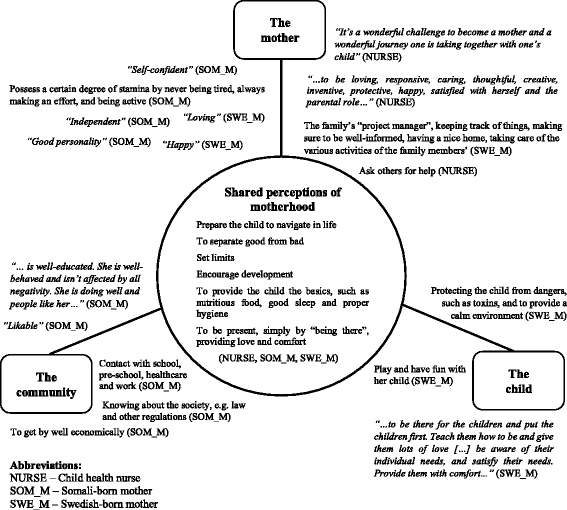When they talk about motherhood: a qualitative study of three groups' perceptions in a Swedish child health service context
- PMID: 27342849
- PMCID: PMC4920994
- DOI: 10.1186/s12939-016-0387-8
When they talk about motherhood: a qualitative study of three groups' perceptions in a Swedish child health service context
Abstract
Background: In light of the growing emphasis on individualization in healthcare, it is vital to take the diversity of inhabitants and users into consideration. Thus, identifying shared perceptions among group members may be important in improving healthcare that is relevant to the particular group, but also perceptions of the staff with whom interactions take place. This study investigates how motherhood is perceived among three groups: Somali-born mothers; Swedish-born mothers; and nurses at Swedish child health centers. Inequities in terms of access and satisfaction have previously been identified at the health centers.
Methods: Participants in all three groups were asked to finalize two statements about motherhood; one statement about perfect motherhood, another about everyday motherhood. The responses were analyzed using qualitative coding and categorization to identify differences and similarities among the three groups.
Results: The responses to both statements by the three groups included divergences as well as convergences. Overall, biological aspects of motherhood were absent, and respondents focused almost exclusively on social matters. Working life was embedded in motherhood, but only for the Somali-born mothers. The three groups put emphasis on different aspects of motherhood: Somali-born mothers on the community; the Swedish-born mothers on the child; and the nurses on the mother herself. The nurses - and to some extent the Swedish-born mothers - expected the mother to ask for help with the children when needed. However, the Somali-born mothers responded that the mother should be independent, not asking for such help. Nurses, more than both groups of mothers, largely described everyday motherhood in positively charged words or phrases.
Conclusion: The findings of this paper suggest that convergences and divergences in perceptions of motherhood among three groups may be important in equitable access and utilization of healthcare. Individualized healthcare requires nuance and should avoid normative or stereotypical encounters by recognizing social context and needs that are relevant to specific groups of the population.
Keywords: Child health; Country of birth; Motherhood; Social construction; Sweden; User perceptions.
Similar articles
-
Antenatal care for Somali-born women in Sweden: Perspectives from mothers, fathers and midwives.Midwifery. 2019 Jul;74:107-115. doi: 10.1016/j.midw.2019.03.022. Epub 2019 Mar 29. Midwifery. 2019. PMID: 30953966
-
Public health care nurses' views of mothers' mental health in paediatric healthcare services: a qualitative study.Prim Health Care Res Dev. 2015 Sep;16(5):470-80. doi: 10.1017/S1463423615000055. Epub 2015 Feb 16. Prim Health Care Res Dev. 2015. PMID: 25684101
-
Being a bridge: Swedish antenatal care midwives' encounters with Somali-born women and questions of violence; a qualitative study.BMC Pregnancy Childbirth. 2015 Jan 16;15:1. doi: 10.1186/s12884-015-0429-z. BMC Pregnancy Childbirth. 2015. PMID: 25591791 Free PMC article.
-
How do health professionals support pregnant and young mothers in the community? A selective review of the research literature.Women Birth. 2014 Sep;27(3):174-8. doi: 10.1016/j.wombi.2014.05.004. Epub 2014 Jun 3. Women Birth. 2014. PMID: 24933525 Review.
-
Construction of meaningful identities in the context of rheumatoid arthritis, motherhood and paid work: A meta-ethnography.J Clin Nurs. 2017 Dec;26(23-24):4117-4128. doi: 10.1111/jocn.13940. Epub 2017 Sep 4. J Clin Nurs. 2017. PMID: 28639276 Review.
References
-
- Levin B, Norrman R. Healthcare’s opportunity: a model for tomorrow’s health and elderly care (Vårdens chans: En modell för morgondagens vård och äldreomsorg) Falun: Ekerlids förlag; 2000.
-
- Nordgren L. From patient to customer (Från patient till kund) 2007.
MeSH terms
LinkOut - more resources
Full Text Sources
Other Literature Sources
Medical


